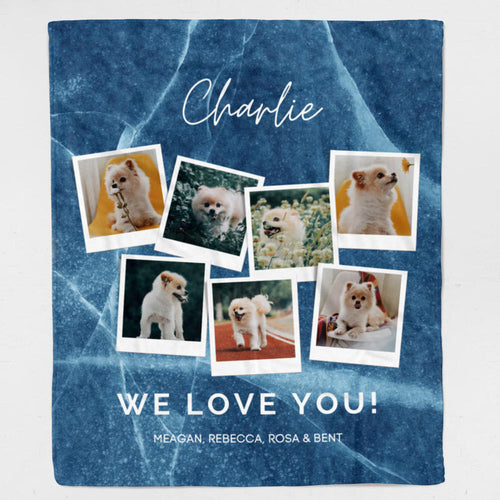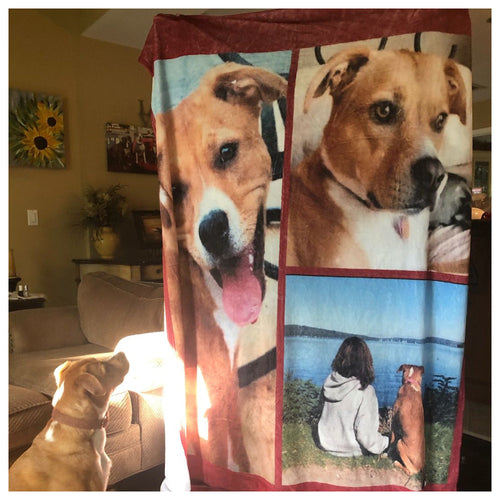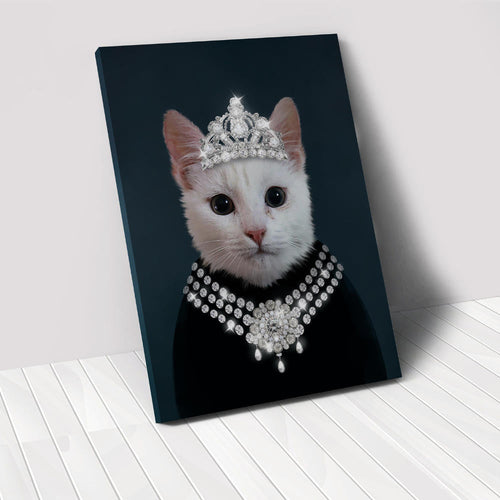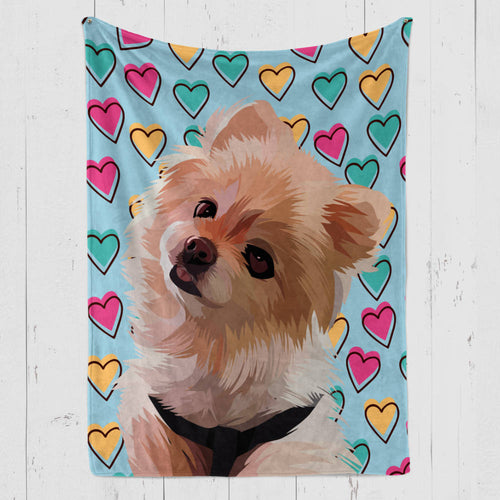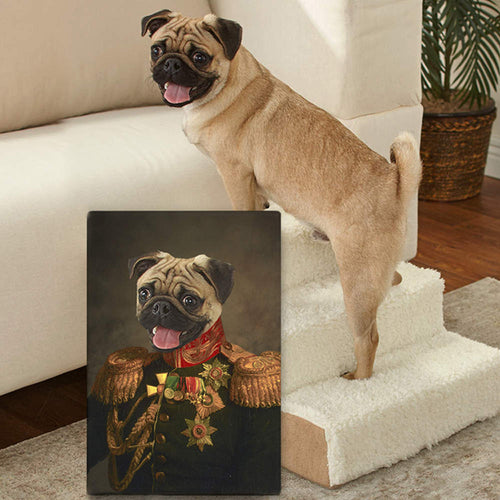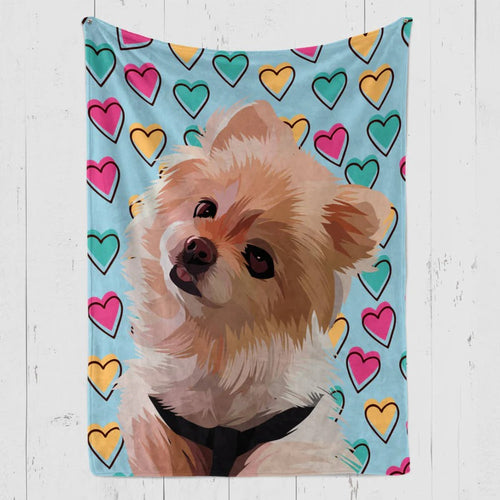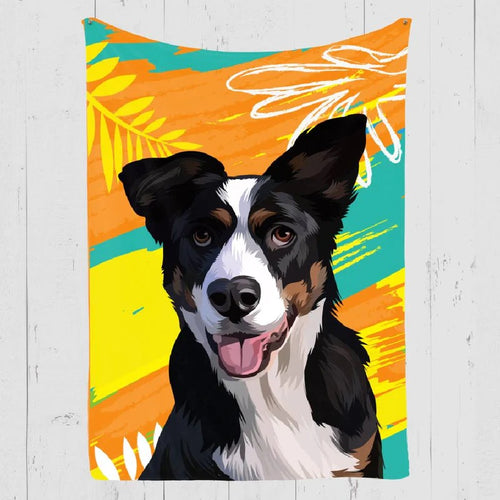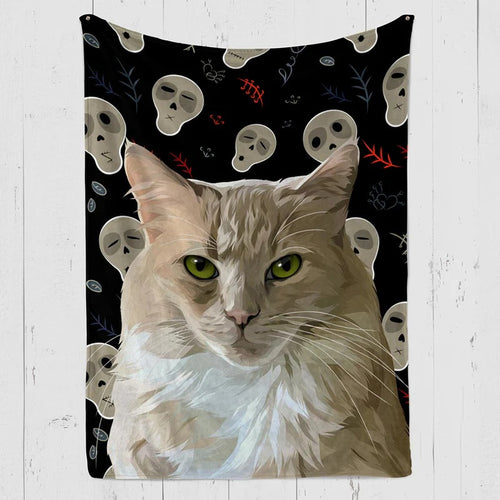
Portuguese is a Southwestern European country with a variety of unique and fascinating dog breeds. Their origin is of deep historic importance mingling with the country's traditions and cultures. They have a range of appearances, temperament, and purposes.
As Portugal is a country with water borderlines and agricultural landfills, most of the Portuguese dog breeds are bred with the intention of life outdoors. They also make a friendly atmosphere at domestic levels and when trained properly can keep up with the energy needs.
What are the 7 Famous Portuguese Dog Breeds?
1. Portuguese Water dog

Hailing from the beautiful coastal regions of Portugal, the Portuguese water dog is a well-loved breed renowned for its exceptional athleticism and affinity for water. In Portuguese they are referred to as Cão de Água Português.
These remarkable dogs are often found on ships and fishing boats, where their natural aquatic talent is put to good use. With a uniquely dense coat, they are able to stay warm even when soaking wet, making them perfect for maritime environments.
This Portuguese dog’s breed had their muscular build with utmost importance in their history, as they were often employed for retrieving lost fishing gear, transporting messages from ship to shore, and saving lives in the event of someone falling overboard.
- Group : Working
- Height : In males they range from 20 to 23 inches. In females they range from 17 to 21 inches.
- Weight : In males they range from 42 to 60 pounds. In females they range from 35 to 50 pounds.
- Energy Level : Hyper Energetic
- Physical Characteristics : Medium sized, well muscled body, head is longer than the muzzle, dropped ears, tail is usually docked to about one-third of its original length.
- Lifespan : Expected to live 11 to 13 years
- Color : Black, Brown, White, Parti-Color, Silver (rare)
- Shedding : Very little
- Bark : Strong, clear, and deep
2. Portuguese Podengo (Podengo Português)

Portuguese Podengo is a hound variety with a highly playful companion to families and active hunting skills as well. It being the national dog of Portugal is well recognized with giant ears and other physical features.
However, this breed is sweet but not that intelligent. They are generally found in three sizes: Large (Grande), Medium (Medio) and Small (Pequeno).
- Group : Miscellaneous
- Height : Large 55-70 cm, medium 40-54 cm, small-30 cm
- Weight : Large 20-30 kg, medium 16-20 kg, small 4-6 kg
- Energy Level : Very High
- Physical Characteristics : smooth, dense coat, almond shaped eyes with good muscular build
- Lifespan : Expected to live 8 to 20 years
- Color : Yellow, black, or brown
- Shedding : Moderate
3. Portuguese Podengo Pequeno

The Portuguese Podengo Pequeno, commonly referred to as PPP, is a breed of the Podengo family that boasts the title of being the smallest of its kind. Despite its diminutive size, the American Kennel Club recognizes this portuguese dog’s breed, highlighting its significance in the canine world.
These adorable pups made their way from Portugal to the Americas, where they were employed as rat catchers. Remarkably, these dogs from Portugal still possess their exceptional hunting instincts and are known to be skilled rabbit hunters. It is worth noting that despite their small stature, they require a considerable amount of exercise to maintain their health and well-being.
- Group : Hound
- Height : They range between 8 to 12 inches
- Weight : They range between 9 to 13 pounds
- Energy Level : High
- Physical Characteristics : wedge shaped head, erect pointed ears, almond-shaped eyes
- Lifespan : Expected to live 12 to 15 years
- Color : Fawn, Yellow, Chestnut, Red, Black, and Tan
- Shedding : Low to little
- Bark : Moderate
4. Portuguese Cattle Dog

This Portuguese dog known as the Portuguese cattle dog is also referred to as Cão de Castro Laboreiro, meaning "dog of Castro Laboreiro" in Portuguese. However, its most significant name is the "Portuguese watchdog" as this Portuguese guard dog has a role in guarding herds of livestock. These dogs possess a robust and brave nature, capable of facing even the most ferocious predators such as wolves.
They are a rare breed outside of the region surrounding Castro Laboreiro. With their tall, muscular, and athletic build, they have been known to engage in battles with wolves to protect cattle. Unfortunately, there are believed to be less than 500 Portuguese cattle dogs remaining today.
- Group : N/A
- Height : They range between 20 to 24 inches
- Weight : They range between 55 to 90 pounds
- Energy Level : High
- Physical Characteristics : mastiff-type, rectangular body, with bushy tail
- Lifespan : Expected to live 12 to 15 years
- Color : dark or light wolf color
- Shedding : mostly Heavy
- Bark : Very distinctive bark
5. Barbado da Terceira

The Barbado da Terceira is a type of dog that comes from the Portuguese island of Terceira. These Portuguese dogs are related to different dogs used for herding and guarding in Portugal. Even though they were not brought to mainland Portugal until the end of the 20th century, they were officially recognized in 2004.
These dogs are smart and athletic and love to interact with humans. They can be trained, but don't like being alone. One interesting thing about them is that they show their intelligence, playfulness, and a bit of mischief in their eyes and expressions. They were originally bred for herding cattle, but are now popular as a pet in Portugal and look similar to the Portuguese Sheepdog.
- Group : Foundation Service Stock
- Height : In males they range from 20.5 to 22 inches. In females they range from 19 to 21 inches.
- Weight : In males they range from 55 to 60 pounds. In females they range from 46 to 57 pounds.
- Energy Level : Moderate to High
- Physical Characteristics : distinctive head, sturdy and muscular body with a deep chest, square-shaped muzzle, medium sized triangular ears, dark brown eyes
- Lifespan : Expected to live 12 to 14 years
- Color : Black, Fawn, Yellow, Grey
- Shedding : Does not shed
- Bark : Moderate to low
6. Alentejo Mastiff

Also known as Portuguese Mastiff or Rafeiro do Alentejo are the largest Portuguese dog breeds. Bred specifically for the protection of farms and herds, these noble dogs possess a sturdy physique and long legs. Despite their calm temperament, they remain ever watchful and poised to defend anything or anyone they perceive as a ward.
It is worth noting that their years of night watch duties have instilled a nocturnal nature, making them more active during nighttime hours. Their unwavering loyalty and fierce protectiveness over their family and territory are traits that truly set them apart.
- Group: Guardian Dog
- Height: They are 26 to 29 inches for males. They are 25 to 27.5 inches in females.
- Weight: 130 lbs to 170 lbs
- Energy level: Average
- Physical Characteristics: large head, small eyes, longer than tall with broad chest
- Lifespan: 12 to 15 years
- Color: Black, Fawn, Wolf Gray, Yellow with White markings
- Shedding: Moderate
7. Portuguese Pointer

The Portuguese Pointer, also called the Perdigueiro Portugues, is a type of hunting dog that has been used for centuries to hunt birds and small game. They were brought to Portugal in the 12th century and were initially used for falconry, where they would assist the hawk in spotting prey.
These Portuguese dogs are known for their strong bond with their handlers and their tireless work ethic. They have a long history in Portugal and were bred specifically for hunting. This Portuguese hunting dog breed eventually made its way to England and played an important part in the creation of the English Pointer.
- Group : Foundation Service Stock
- Height : They range between 20 to 25 inches
- Weight : They range between 35 to 59 pounds
- Energy Level : Very High
- Physical Characteristics : Square body with same back to tail ratio, square face with hanging down ears along with a black nose
- Lifespan : Expected to live around 14 years
- Color : Brown, Light-brown, Yellow, White & Yellow, White & Light Brown
- Shedding : Very Little
- Bark : Very rarely barks
Takeaway
Adopting a Portuguese dog breed is a rewarding decision in itself but there are some criteria that you must keep in mind before adopting. First, you need to learn about their temperament, requirements, and suitable environment for any potential health issues that must be pre considered.
When the decision of adoption is finalized, you can either visit any reputable rescue foundations or contact a well-known verified dog breeder. Visiting the dog can improve connection gradually as it takes time for both the dog and its owner to understand each other's habituality and requirements. Building the bond stronger requires interaction and physical touch.
Bringing the pup home must be done with utmost concern. Any kind of hazardous tools must be kept away and complete surveillance during the initial days is important. Plus, regular visits to Veterinary care and first aid must be compulsory. Short training sessions and socialization will make your child committed and loving.
Frequently Asked Questions
How did the Portuguese water dog originate?
Portugal is predominantly surrounded by water, making it a common practice for fishermen to bring along Portuguese water dogs as their companions on boats. These dogs not only functioned as working dogs but also played an important role in herding fish nets and retrieving lost equipment on the ship. Over time, they developed an athletic temperament and became proficient swimmers, thanks to their waterproof coats and webbed feet.
Name a few Portuguese dog breeds that originated in the country.
Here are a few Portuguese dogs that are native breeds.
- Barbado da Terceira
- Cão de Gado Transmontano
- Catro Laboreiro Dog
- Estrela Mountain Dog
- Portuguese Podengo
- Portuguese Pointer
- Portuguese Sheepdog
Which Portugal breed is considered the national breed of Portugal?
The national dog of Portugal is the Portuguese Water Dog, which is known locally as the "Cão de Água Português". This breed has a strong historical association with Portugal and is regarded as a prized national treasure.
Portuguese Water Dogs were initially bred to assist fishermen in various water-related duties, including herding fish into nets, retrieving lost fishing gear, and acting as messengers between boats and land. Its key characteristics are - great swimming abilities, intelligence, curly wand wavy coat, loyalty, and energy
Which Portuguese dog breed is known for its livestock guarding abilities?
The Alentejo Mastiff, also known as the Cão de Castro Laboreiro or Portuguese Mastiff, is a breed highly valued for its ability to guard livestock. These dogs possess protective instincts and demonstrate bravery in defending herds against predators.
Throughout history, they were primarily used to guard cattle and sheep from wolves and bears. Nowadays, they are still highly regarded for their role as loyal companions and guardians.
However, due to their protective nature, they are best suited for experienced dog owners who are familiar with the characteristics and needs of guardian breeds.
Which Portuguese dog breed served as the First Family's pet in the United States during President Barack Obama's time in office?
During his first term in the White House, former U.S. President Barack Obama and his family adopted a Portuguese Water Dog named Bo as their First Dog. In 2013, during his second term, they welcomed another PWD named Sunny into their home. Bo and Sunny's presence in the Obama family home helped to showcase the breed's versatility and appeal, gaining international recognition and popularity.
Latest Review on Woof Blankets
To have such a masterpiece by my side every day is a gift for me and my memories with Rex. Thank you WoofBlankets for such an opportunity to recreate his image on a blanket.Lara o’ Miguel US, California

COLLECTION WORTH EVERY PENNY
BEST SELLERS
-
Woofy Single Color Custom Pet Blanket
![Woofy Single Custom Pet Blanket – Woof Blanket]()
- -41%
BlanketsSHOP NOW- Regular price
- from $64.95
- Sale price
- from $64.95
- Regular price
-
$109.95 - Unit price
- per
Sold out -
Exclusive Christmas Custom Pet Blanket
![Exclusive Custom Pet Blanket]()
- -39%
BlanketsSHOP NOW- Regular price
- from $69.95
- Sale price
- from $69.95
- Regular price
-
$114.95 - Unit price
- per
Sold out -
Christmas Custom Pet Blanket
![Christmas Custom Pet Blanket - Custom Dog Blankets]()
- -40%
BlanketsSHOP NOW- Regular price
- from $69.95
- Sale price
- from $69.95
- Regular price
-
$115.95 - Unit price
- per
Sold out -
Watercolor Pet Portraits
![]() SHOP NOW
SHOP NOW- Regular price
- from $59.95
- Sale price
- from $59.95
- Regular price
-
- Unit price
- per
Sold out -
Woofy Christmas Custom Dog Blanket
![Woofy Christmas Custom Dog Blanket]()
- -39%
BlanketsSHOP NOW- Regular price
- from $69.95
- Sale price
- from $69.95
- Regular price
-
$114.95 - Unit price
- per
Sold out -
Modern Pet Owner Portrait
![]()
- -32%
CanvasSHOP NOW- Regular price
- from $84.95
- Sale price
- from $84.95
- Regular price
-
$124.95 - Unit price
- per
Sold out -
Woof Splash Custom Pet Blanket
![Woof Splash Custom Pet Blanket]()
- -39%
BlanketsSHOP NOW- Regular price
- from $69.95
- Sale price
- from $69.95
- Regular price
-
$114.95 - Unit price
- per
Sold out -
The Admiral - Custom Pet Portrait
![The Admiral - Custom Pet Portrait Online]()
- NEW
- -25%
CanvasSHOP NOW- Regular price
- from $59.95
- Sale price
- from $59.95
- Regular price
-
$79.95 - Unit price
- per
Sold out -
Wings of Loyalty - Custom Pet Portrait
![]()
- NEW
CanvasSHOP NOW- Regular price
- from $59.95
- Sale price
- from $59.95
- Regular price
-
- Unit price
- per
Sold out -
Pet Memorial Custom Photo Collage Blanket
![Personalized pet memorial quilt with photos]()
- -41%
BlanketsSHOP NOW- Regular price
- from $64.95
- Sale price
- from $64.95
- Regular price
-
$109.95 - Unit price
- per
Sold out -
Celestial Paws - Custom Pet Portrait
![]() CanvasSHOP NOW
CanvasSHOP NOW- Regular price
- from $59.95
- Sale price
- from $59.95
- Regular price
-
- Unit price
- per
Sold out -
The Loyal Soul - Custom Pet Portrait
![]()
- NEW
SHOP NOW- Regular price
- from $59.95
- Sale price
- from $59.95
- Regular price
-
- Unit price
- per
Sold out -
Cartoonized Pet Portraits (New)
![Cartoonized Pet Custom Portraits Online]()
- -36%
SHOP NOW- Regular price
- from $59.95
- Sale price
- from $59.95
- Regular price
-
$93.95 - Unit price
- per
Sold out -
The French Sailor - Custom Pet Portrait
![]()
- -25%
CanvasSHOP NOW- Regular price
- from $59.95
- Sale price
- from $59.95
- Regular price
-
$79.95 - Unit price
- per
Sold out -
The Policeman - Custom Pet Portrait
![]()
- NEW
- -25%
CanvasSHOP NOW- Regular price
- from $59.95
- Sale price
- from $59.95
- Regular price
-
$79.95 - Unit price
- per
Sold out -
The General - Custom Pet Portrait
![]()
- NEW
- -25%
CanvasSHOP NOW- Regular price
- from $59.95
- Sale price
- from $59.95
- Regular price
-
$79.95 - Unit price
- per
Sold out -
Woof Love Custom Pet Blanket
![Woof Love Custom Pet Blanket]()
- -39%
BlanketsSHOP NOW- Regular price
- from $69.95
- Sale price
- from $69.95
- Regular price
-
$114.95 - Unit price
- per
Sold out -
Summer Time Custom Pet Blanket
![Summer Time Custom Pet Blanket]()
- -39%
BlanketsSHOP NOW- Regular price
- from $69.95
- Sale price
- from $69.95
- Regular price
-
$114.95 - Unit price
- per
Sold out -
The Ambassador - Custom Pet Portrait
![The Ambassador - Custom Pet Portrait Online]()
- NEW
- -25%
CanvasSHOP NOW- Regular price
- from $59.95
- Sale price
- from $59.95
- Regular price
-
$79.95 - Unit price
- per
Sold out -
Fall In Love Custom Pet Blanket
![Fall In Love Custom Dog Blanket]()
- NEW
- -39%
BlanketsSHOP NOW- Regular price
- from $69.95
- Sale price
- from $69.95
- Regular price
-
$114.95 - Unit price
- per
Sold out -
The Classy Lady - Custom Pet Portrait
![The Classy Lady]()
- NEW
- -25%
CanvasSHOP NOW- Regular price
- from $59.95
- Sale price
- from $59.95
- Regular price
-
$79.95 - Unit price
- per
Sold out -
The Duke - Custom Pet Portrait
![The Duke - Custom Pet Portrait]()
- NEW
- -25%
CanvasSHOP NOW- Regular price
- from $59.95
- Sale price
- from $59.95
- Regular price
-
$79.95 - Unit price
- per
Sold out -
Dog In Suit- Custom Pet Portrait
![Dash Dog In Suit- Custom Pet Portrait Online]()
- NEW
- -25%
CanvasSHOP NOW- Regular price
- from $59.95
- Sale price
- from $59.95
- Regular price
-
$79.95 - Unit price
- per
Sold out -
The Princess - Custom Pet Portrait
![]()
- NEW
- -25%
CanvasSHOP NOW- Regular price
- from $59.95
- Sale price
- from $59.95
- Regular price
-
$79.95 - Unit price
- per
Sold out -
Modern Pet Portrait with One Mug
![Modern Pet Portrait with One Mug]()
- -25%
Print MaterialSHOP NOW- Regular price
- from $99.95
- Sale price
- from $99.95
- Regular price
-
$133.95 - Unit price
- per
Sold out -
The Aristocrat - Custom Pet Portrait
![The Aristocrat - Custom Pet Portrait At Best Price]()
- NEW
- -25%
CanvasSHOP NOW- Regular price
- from $59.95
- Sale price
- from $59.95
- Regular price
-
$79.95 - Unit price
- per
Sold out -
Single Color Custom Blanket with 1 Mug
![Single Color Custom Blanket with 1 Mug]() BlanketsSHOP NOW
BlanketsSHOP NOW- Regular price
- from $99.95
- Sale price
- from $99.95
- Regular price
-
- Unit price
- per
Sold out -
Single Color Custom Blanket with 2 Pillows
![Single Color Custom Pet Blanket with 2 Pillows]()
- -21%
BlanketsSHOP NOW- Regular price
- from $99.95
- Sale price
- from $99.95
- Regular price
-
$125.95 - Unit price
- per
Sold out -
The Dog in Suit Custom Pet Mug
![]()
- -20%
MugsSHOP NOW- Regular price
- $39.95
- Sale price
- $39.95
- Regular price
-
$49.95 - Unit price
- per
Sold out -
Angel Custom Pet Mug
![]()
- -20%
MugsSHOP NOW- Regular price
- $39.95
- Sale price
- $39.95
- Regular price
-
$49.95 - Unit price
- per
Sold out -
This Human Belongs To - Custom Pet Mug
![]()
- NEW
- -20%
MugsSHOP NOW- Regular price
- $39.95
- Sale price
- $39.95
- Regular price
-
$49.95 - Unit price
- per
Sold out -
It's Not Dog Hair Custom Pet Mug
![]()
- NEW
- -20%
MugsSHOP NOW- Regular price
- $39.95
- Sale price
- $39.95
- Regular price
-
$49.95 - Unit price
- per
Sold out -
My Dog Is My Valentine Custom Pet Mug
![]()
- NEW
- -20%
MugsSHOP NOW- Regular price
- $39.95
- Sale price
- $39.95
- Regular price
-
$49.95 - Unit price
- per
Sold out -
3 Photos With Message Custom Pet Mug
![]()
- NEW
- -20%
MugsSHOP NOW- Regular price
- $39.95
- Sale price
- $39.95
- Regular price
-
$49.95 - Unit price
- per
Sold out -
My Valentine Has Four Legs- Personalized Mugs
![]()
- NEW
- -20%
MugsSHOP NOW- Regular price
- $39.95
- Sale price
- $39.95
- Regular price
-
$49.95 - Unit price
- per
Sold out -
Dog Mamma Custom Pet Coffee Mug
![]()
- -20%
MugsSHOP NOW- Regular price
- $39.95
- Sale price
- $39.95
- Regular price
-
$49.95 - Unit price
- per
Sold out -
Uncle Sam - Custom Pet Portrait
![]()
- NEW
- -25%
CanvasSHOP NOW- Regular price
- from $59.95
- Sale price
- from $59.95
- Regular price
-
$79.95 - Unit price
- per
Sold out -
The Revolutionary Emperor - Custom Pet Portrait
![]()
- NEW
- -25%
CanvasSHOP NOW- Regular price
- from $59.95
- Sale price
- from $59.95
- Regular price
-
$79.95 - Unit price
- per
Sold out -
The Princess Paws - Custom Pet Portrait
![]()
- -25%
CanvasSHOP NOW- Regular price
- from $59.95
- Sale price
- from $59.95
- Regular price
-
$79.95 - Unit price
- per
Sold out -
The Dark Crusader Knight - Custom Pet Portrait
![]()
- -25%
CanvasSHOP NOW- Regular price
- from $59.95
- Sale price
- from $59.95
- Regular price
-
$79.95 - Unit price
- per
Sold out
